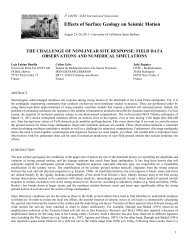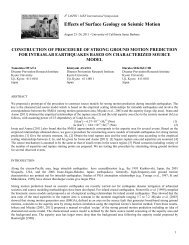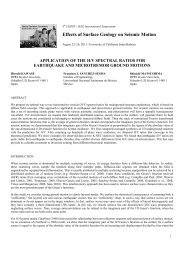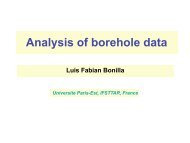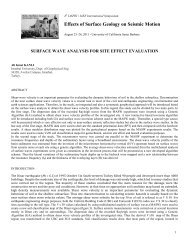a new strategy for developing vs30 maps - ESG4 Conference @ UCSB
a new strategy for developing vs30 maps - ESG4 Conference @ UCSB
a new strategy for developing vs30 maps - ESG4 Conference @ UCSB
Create successful ePaper yourself
Turn your PDF publications into a flip-book with our unique Google optimized e-Paper software.
sampled at the same 30 arc-second sampling grid sampling as the topographic slope. The values of slope and geology category are<br />
determined at each Vs 30 observation location. Then using R, we regress the equation (2) using ordinary least squares to determine the<br />
coefficients, which are passed back to GMT.<br />
Validation (Point)<br />
Vs30 Data Set<br />
Interpolation<br />
(Point)<br />
Vs30 Data Set<br />
Continuous Predictor:<br />
Topography<br />
(Gridded) Data<br />
Categorical<br />
Predictor: Geology<br />
(Polygon) Data<br />
resample<br />
resample<br />
find slope at<br />
Vs30 sites<br />
geology at<br />
Vs30 sites<br />
Topographic<br />
Slope<br />
(Gridded)<br />
Cross-term<br />
analysis<br />
Geology Grid<br />
(indicator<br />
variables)<br />
fit remaining<br />
trend<br />
Fit<br />
Coefficients<br />
(Ordinary<br />
Least<br />
Squares)<br />
Regression<br />
Residuals<br />
Trend<br />
Estimates<br />
Analyze residuals<br />
<strong>for</strong> spatial correlation<br />
(model variogram <strong>for</strong><br />
kriging)<br />
Interpolate<br />
Residuals<br />
(Ordinary<br />
Kriging)<br />
Add interpolated<br />
residuals<br />
to fitted trend<br />
Derive<br />
Prediction Error<br />
Evaluate<br />
Accuracy<br />
of<br />
Estimates<br />
Final Prediction<br />
Vs30 Map<br />
Vs30 Uncertainty<br />
Map<br />
Fig. 4. Flow chart <strong>for</strong> data processing, data analysis, regression modeling, and kriging. GMT processes are shown in<br />
green; R functions in blue; white ovals are input data sets. Validation, refitting, and prediction error calculations (dashed<br />
lines) have not yet been attempted. See text <strong>for</strong> details.<br />
The <strong>for</strong>ward calculation, estimating Vs 30 at all grid points, is done efficiently with GMT’s grid math processing and the results are<br />
mapped in Fig. 5b. Next, residuals of the Vs 30 data from the <strong>for</strong>ward model are determined at each observation point. Back in R (Fig.<br />
3), kriging preprocessing involves generating and fitting a variogram (usually an exponential function) and determination of<br />
appropriate sill, nugget, and range values (Fig. 6). The residuals are then kriged using these data-specific spatial correlation values,<br />
and the results are resampled on the same uni<strong>for</strong>m grid, which can be mapped back in GMT (Fig. 5c). Finally, the gridded, kriged<br />
residuals are summed directly with the joint slope and geologic trend model to <strong>for</strong>m the final Vs 30 map (Fig. 5d).<br />
7



